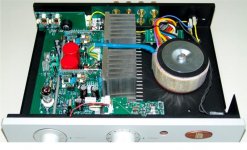Hi, being a coward with the soldering iron, I decided to shell out big bucks and go for the big boy's toy- my first high end amplifier. I currently have my eyes on Naim Nait 5i and Unico P from Unison Research. They're both internet buys and at about same price- used. I had demoed Unico in the past and believe it to be worth the money that I'm willing to pay for. I have no idea about the Nait, though. My audioholic senses tell me it's the better buy. But what do you think? Please let me know.
I have heard both, but not at the same time for a directly compare. But I can clearly say, that the reliability by Naim Audio is much more higher than by Unison Research. And additional service/repair work is much more easy than by Unison Research.
Photos Of NAIM Nait 5i & other hi-fi
Photos Of NAIM Nait 5i & other hi-fi
Attachments
Last edited:
Hi, probably a hopeless question, but which amp do you remember to have enjoyed the more? I realize the amps couldn't have been the only variable but I have no opportunity to demo them.. 🙁
Nothing of both (I know the sound character of single ended amp topologies like "ZEN" and "Aleph" and therefore I am spoiled). In the upper frequency range sound of both is harsh (naturally character of all amps with class AB idle current <50mA through the output stage). But for the low frequency aera I would prefer the Naim Nait 5i (more tight and clear).
Last edited:
thanks. I think I'm being steered toward a Pass amp, also. Currently I found an offering for Mini Aleph with saucer transitors: chinese iteration- PASS AM ´¿¼×À๦·Å£¬ºó¼¶£¬ÒôÉ«ÌðÃÀ - ÌÔ±¦Íø. I found Unico to be an impressive performer with smooth mids and extended highs when i demoed it with my inexperienced ears. So you're saying there even more of that goodness to be found in a Nelson Pass design? is the bass and the dynamic going to suffer noticeably with the exchange? lastly, I thought Unico P was class A mosfet?
thanks. I think I'm being steered toward a Pass amp, also. Currently I found an offering for Mini Aleph with saucer transitors: chinese iteration- PASS AM ´¿¼×À๦·Å£¬ºó¼¶£¬ÒôÉ«ÌðÃÀ - ÌÔ±¦Íø. I found Unico to be an impressive performer with smooth mids and extended highs when i demoed it with my inexperienced ears. So you're saying there even more of that goodness to be found in a Nelson Pass design? is the bass and the dynamic going to suffer noticeably with the exchange? lastly, I thought Unico P was class A mosfet?
Unfortunately my english isn't so good, that I understand your questions absolut exactly.
The Amp about
PASS AM ´¿¼×À๦·Å£¬ºó¼¶£¬ÒôÉ«ÌðÃÀ - ÌÔ±¦Íø
I cannot recommend, because the quality at least of capacitors isn't good (have a look to the photo of that auction).
Some people claim, the Unico P was class A. But what means that? For me the actually question must be, what is the exactly value of the idle current through the output stage (not the whole value of the amp)? If there are 100 mA, then all power below 100 mA through the loudspeaker is pure class A. If there are 20 mA, then all power below 20 mA through the loudspeaker is pure class A. This means only low level in pure class A.
check out this threads:
http://www.diyaudio.com/forums/soli...ended-integrated-power-amplifier-devices.html and
http://www.diyaudio.com/forums/soli...n-single-ended-solid-state-output-stages.html
The best way to got a cheap pure class a is continue checking the offers about used diy-amps in pure class A or even single ended. In the second step I would additional buy a integrated amp in ordinary Class AB with a pre-out for the use in lower frequency range, especially if you have low efficiency speakers.
Last edited:
hi. thank you for your continuing inputs. I'm pretty set on this chinese diy amp, however. 1000rmb is not that expensive for a starter amp. I agree it's got some shoddy components but I figure if i like the sound enough as it is, this will be my first guinea pig amp for diy. at least the transformer are real potted core types and europian made, according to the ad. I'm not a fan of bi-amping, if that's what you're suggesting. last time i tried that, the timing was off due to the different slew rate between the amps and that made the music lose coherency.
- Status
- Not open for further replies.
- Home
- Amplifiers
- Solid State
- My first high end amp:Naim Nait or Unison Research Unico?
